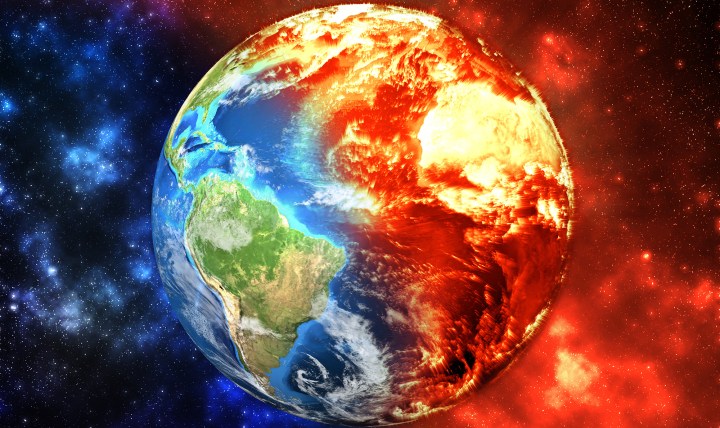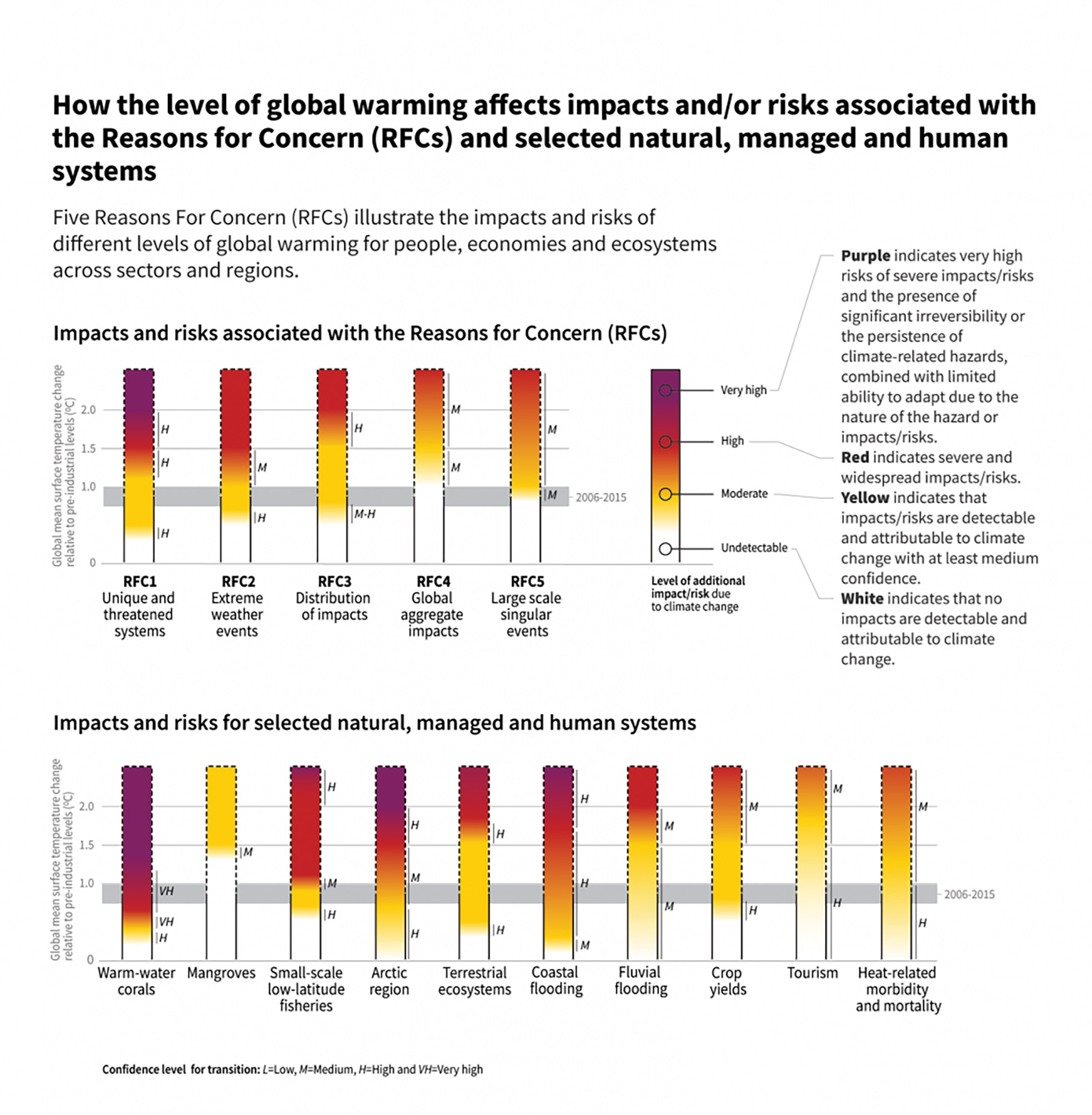OUR BURNING PLANET
Global average temperature predicted to temporarily rise above tipping point in next five years

With carbon dioxide emissions poised to rise to record highs in 2023 and global average temperatures potentially reaching above the 1.5°C tipping point in the next five years, the climate crisis has never been more salient.
Some time in the 2030s, it is projected, the global average temperature will have increased from pre-industrial levels by 1.5°C. For South Africa to avoid the multi-year droughts, severe heatwaves and extreme weather events expected to accompany this change, greenhouse gas emissions need to be radically reduced — and soon.
It should be concerning then that the International Energy Agency (IEA) this week announced that “full and timely implementation of the economic recovery measures announced to date would result in CO2 emissions climbing to record levels in 2023, continuing to rise thereafter”.
At the same time, the World Meteorological Organization (WMO), a specialised agency of the United Nations, has predicted that it is increasingly likely that the annual average global temperature will temporarily reach 1.5°C above pre-industrial levels in at least one of the next five years.
The IEA’s Sustainable Recovery Tracker report notes that, of the estimated $16-trillion in fiscal support marshalled by governments aimed at stabilising and rebuilding their economies in the wake of the pandemic-induced economic crises, only $380-billion — or roughly 2% — has been directed to clean energy measures.
“Not only is clean energy investment still far from what’s needed to put the world on a path to reaching net-zero emissions by mid-century, it’s not even enough to prevent global emissions from surging to a new record,” said Dr Fatih Birol, executive director of the IEA.
We just launched @IEA’s new Sustainable Recovery Tracker to measure how governments’ responses to the Covid-19 crisis are affecting clean energy investment & CO2 emissions.
It shows that only 2% of fiscal support goes to clean energy transitions ➡️ https://t.co/8WzlGaDJu5 pic.twitter.com/fvVudGeDMb
— Fatih Birol (@fbirol) July 20, 2021
The WMO predicts that there is about a 40% chance of the annual average global temperature temporarily reaching 1.5°C above pre-industrial levels in at least one of the next five years. The report says that there is a 90% likelihood of “at least one year between 2021-2025 becoming the warmest on record”.
WMO Secretary-General Professor Petteri Taalas said, “These are more than just statistics. Increasing temperatures mean more melting ice, higher sea levels, more heatwaves and other extreme weather, and greater impacts on food security, health, the environment and sustainable development.”
He continued: “This study shows — with a high level of scientific skill — that we are getting measurably and inexorably closer to the lower target of the Paris Agreement on Climate Change. It is yet another wake-up call that the world needs to fast-track commitments to slash greenhouse gas emissions and achieve carbon neutrality.”
(Source: Nasa’s Scientific Visualisation Studio. Data provided by Robert B. Schmunk (Nasa/GSFC GISS).
The UN Intergovernmental Panel on Climate Change (IPCC) has identified the 1.5°C average temperature increase as a tipping point in the climate crisis. It says that after reaching this tipping point, we can expect “warming of extreme temperatures” in many regions, increases in “frequency, intensity and/or amount of heavy precipitation” in several regions, and an increase in “intensity or frequency of droughts”.
“It’s a line in the sand and what it says to our species is that this is the moment and we must act now,” Debra Roberts, a co-chair of the IPCC working group on impacts, said in 2018. Well, that line is likely to be crossed — albeit temporarily for now.

(Source: IPCC)
Professor Francois Engelbrecht, eminent climate scientist and one of the lead authors on the IPCC report, told Daily Maverick that 1.5°C is more than an aspiration and why temporarily crossing that threshold is more a warning of things to come than the start of the end of the world.
“The report found that, indeed, we should try to restrict global warming to 1.5°C and the number one reason for that is that the constantly refining climate science had determined that the threshold at which the Greenland ice cap may start to reverse at an irreversible way may in fact be somewhere between 1.5 and two degrees Celsius of global warming. So staying below two degrees may not even be enough to prevent the irreversible melting of the Greenland ice cap.
“It will take many centuries for the ice sheets to melt away completely if the process is triggered, but still it means our generation will commit future generations to a different world where sea levels are about 12 metres higher than they are today,” he explained.
“In that scenario, we will of course face what is currently regarded as the worst case of what we may see in terms of sea-level rise in this century, which is an increase of about one metre by the end of this century. Now one metre of sea-level rise is already very harmful because that is enough to displace hundreds of millions of people from low-lying areas of the world.”
Engelbrecht explained that: “It is not only about sea-level rise. The report found that a range of extreme weather events will occur more frequently at 1.5°C of global warming than they are happening today. As you and I speak today it is now estimated that we are sitting at 1.2°C of global warming [above pre-industrial levels]. So we are very, very close to the threshold.
“What is important for us in southern Africa is at two degrees Celsius of global warming, risks of multiyear droughts are substantially larger than at 1.5°C of global warming. That’s a very important message for us. Multi-year droughts are the number one climate change risk that South Africa faces in a changing climate.”
The professor explained that the distance between 1.5°C and 2°C, however, is more than a buffer zone.
“There are substantial benefits in the form of reduced risks if we can keep global warming to below 1.5°C. We substantially reduce the impacts of extreme weather events on — for example — countries’ economies. We are starting to gamble as soon as global warming goes above 1.5°C. The impacts don’t always increase linearly as the global warming level increases. So 1.5°C is not an innocent threshold, there is a lot of physics that has a high likelihood of setting in above the threshold of 1.5°C of global warming.”
Asked about the WMO report and the possibility of “temporarily” exceeding the 1.5°C threshold, Engelbrecht responded that, “There is a risk that we can also temporarily exceed that 1.5°C threshold. The world also has a natural variability in its climate and in the global surface temperature. And the main mechanism that causes that variability is the El Niño and La Niña events in the Pacific Ocean.
“Because of this natural variability, if we now should run into a strong El Niño event then the world may temporarily run into that 1.5°C value. As soon as the El Niño disappears or as soon as the La Niña appears then the world’s average temperature will fall again to below 1.5°C.
“Every single year that we continue with pumping carbon dioxide emissions into the atmosphere we continue the planet’s upward trend in temperature. If emissions continue then in 2030 we will reach that 1.5°C threshold and then it becomes permanent.”
The findings of the IEA’s Sustainable Recovery Tracker report read in conjunction with the WMO’s findings are particularly prescient when set against the backdrop of extreme weather events taking place across the globe. These events offer us a glimpse into the none-too-distant projected future if emissions are not reduced substantially and in short order.
In China this week, 25 people died and 100,000 have been evacuated in floods caused by three days of rain described by the Zhengzhou weather bureau as being at a level only observed “once in 1,000 years”. According to the BBC, the equivalent of a year’s average rainfall has fallen in just three days.
In North America, parts of the continent have been scorched by a record-breaking heatwave. A number of cities and towns in the US and Canada recorded temperatures far above 40ºC. In one village in Canada, a new all-time Canadian temperature record of 49.6ºC was set. That same village was destroyed in a wildfire shortly thereafter.
A group of scientists who form the collective World Weather Attribution, using peer-reviewed methods, analysed how human-induced climate change affected the maximum temperatures. Their conclusion is that the extreme heat in the western parts of North America was “virtually impossible without human-caused climate change”.
In November, world leaders will gather at COP26 in Glasgow, Scotland for what is increasingly shaping up to be the latest in a round of crucial climate change negotiations.
From floods in Germany and China to wildfires and heatwaves in Canada and the US, extreme weather events remind us of the urgent need to address the runaway anthropogenic climate change now on full display. DM/OBP






















 Become an Insider
Become an Insider
The focus should not be on reducing greenhouse gas emissions . 4% of global GDP should be used to extract CO2 from the admosphere.The current 420 ppm should be reduced to 350 ppm .The tecnology is there . The threat of global warming should be managed as urgently as a war effort . By focusing on emissions we are taking a pelletgun to war
When the science is as clear as this makes it, why does SA stick its head in the sand? Can only be self interest of our political leadership.
Systemic change is absolutely necessary and I have yet to find anyone who can come up with an alternative to capitalism – or growth economy – which is at the root of climate change. Climate Change is the end game and our government is still wrapped up in greed and corruption side shows.
Capitalism is a convenient scapegoat, imo. Capitalism supplies what consumers demand. The ‘manmade’ factors driving climate change is mostly a demand side problem. It is also, to a lesser extent, a regulatory problem. Anti-capitalist viewpoints jumped on the climate change bandwagon and is one of the reasons the call for lowering emissions meets so much resistance. Climate change has become a controversial issue, with many exaggerations and denials diluting a rational approach. There’s no need for a disruptive revolution – I predict that ironically, profit motive will be the force behind innovations that reduce emissions.
Colleen : capitalism and efficiency and profit is what will drive change. Coal was embraced because it was cheap and easy. Already today solar is for many applications far cheaper.
Communism selects differently – the weights that are applied to jobs for example.
Coal mines in next 30y will undergo what oxwagon manufacturers did when cars became a thing. It was never elegant. It takes a hilux bakkie of coal to power an incandescent light bulb for a year. How did people ever think think this was a clever way of producing light?
The good news is that many of the weapons to mitigate effects are themselves now make commercial sense. Look at the cost of renewable energy. For many businesses, NOT going solar is plainly bad business.
Distributed generation and smart minigrids is where the action will be for next five years. Office blocks and inner cities are a tough nut, but any wine farm or fruit packing store or cold chain product company in SA that has not covered their feasible roofs in solar is plain stupid.
If the world cracks electrical energy storage to below $100/kWh (retail) with even 10,000 cycle life, electrical energy will completely transform from majority fossil to majority renewable. The only reason coal electricity would not disappear immediately is the sunk cost in new plants built this century.
Countries like Norway (98% energy from renewables) did not go green decades ago because they were bunny huggers or early adopters. They are lucky with incredible renewable resource and the renewables made far more economic sense than the alternatives. The same math is expanding its footprint
Reality dictates that SA will generate power for at least the next 3 – 5 decades from coal. On the output side of GHG it would be wise to focus on food production as well. (25% contribution, of which diary is huge, as oppose to mining’s 5 – 7%). As suggested by Andries above CO2 extraction from the atmosphere is possible and viable. Supply and demand forces dictate the world economy, but the creation and aggressive marketing of junk motivated by greed, also plays a role. The world needs a paradigm shift and it is not happening yet.
The headline picture of our ‘planet on fire’ is part of the problem. “Global warming” was changed to “climate change” when predictions of warming failed to materialise – most predictions of the climate change protagonists have not materialised, yet it’s continually called ‘science’. It became convenient to target reducing carbon as the objective, because carbon levels are rising. There is still no consensus across all scientists whether increased carbon is causal to rising temperatures or vice versa. Some evidence suggests rising temperatures cause rising carbon – not the other way around. So maybe all this effort around reducing carbon may be in vain. Al Gore’s 2007 An Inconvenient Truth had heaps of apocalyptic predictions. Not a single one of them materialised. The evidence above, of floods and fires, as being causally linked to climate change is spurious. Natural events have been happening for millions of years. And yes, damage gets worse as there’s been a massive increase in population and also population density, hence natural catastrophes cause more damage. But that’s not the same as their being more natural catastrophes. Rising carbon is also causal to an increase in plant life – evidenced in many regions of the world. The climate change movement might best change it’s name to “pollution change” – maybe that would be far more useful to the planet than targeting reductions in a gas that humans breathe out everyday of their lives and plants soak up to proliferate.